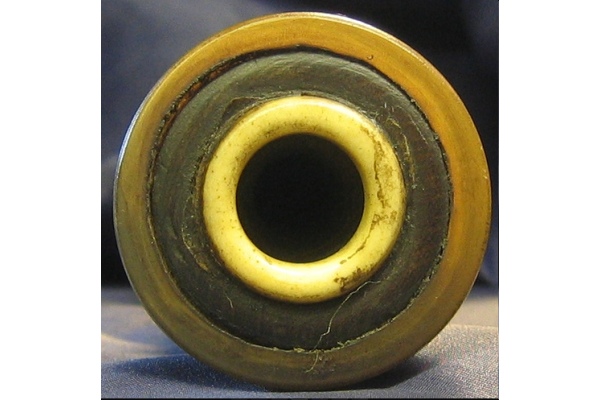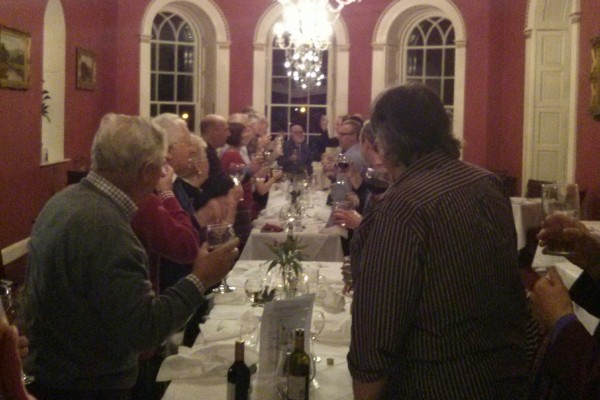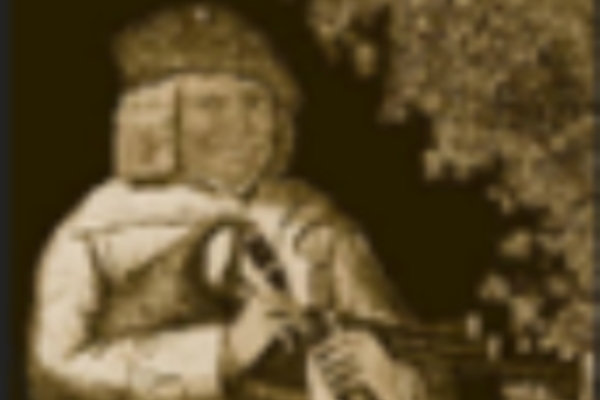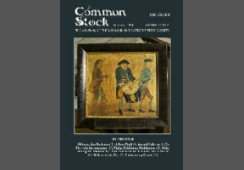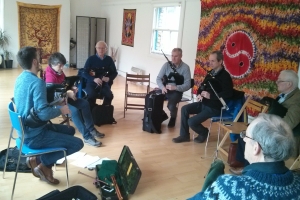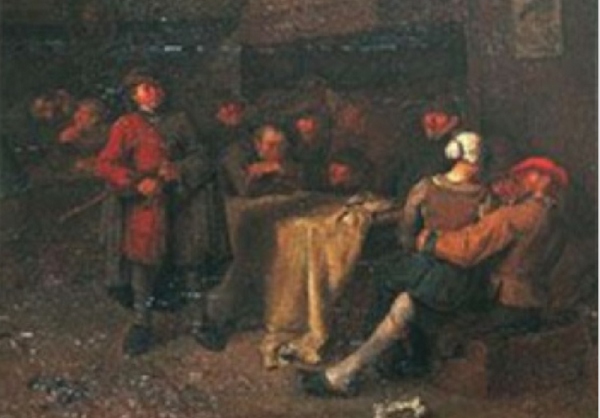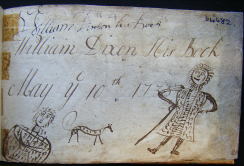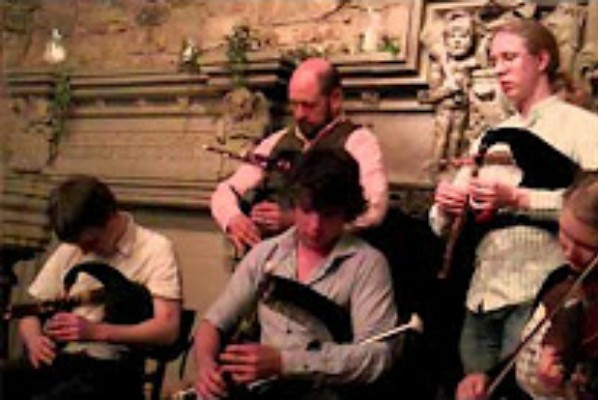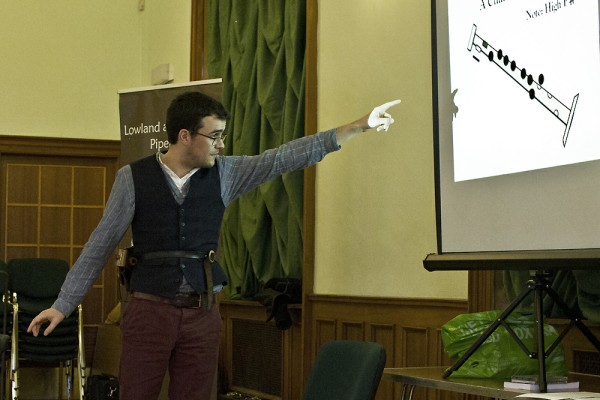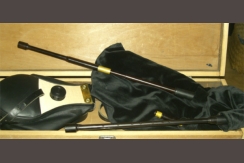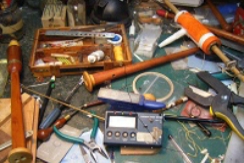During a recent discussion about the triple-time hornpipe the inevitable question arose - ‘when did the common time hornpipe first appear and what were its origins?’
Outside the world of Lowland piping and a small brigade of English fiddlers, the triple-time hornpipe is almost unknown; mention the word ‘hornpipe’ in general circles and you will almost certainly be
regaled with ‘The Sailor’s Hornpipe’, quite possibly with the classic gestures of folded arms etc. And yet, for the first two hundred or more years of its recorded history the hornpipe was entirely in triple time. In my essay ‘The Triple-Time Hornpipe’1 I followed the development of the form from its earliest mentions and first appearances in the early 16th century in England; by the mid-16th century it had become recognised in Europe as being quintessentially English one of the early examples, published in France in 1552 is titled simply ‘Hornpipe d’Angleterre’.2 As the form morphed from 6/4 time to 3/2 it seems to have flourished in the northern regions of England and the Border regions of Scotland. However, by the mid-18th century English dancers were familiar with a different kind of hornpipe, made popular by dancing masters and by stage dancers, many of whom gave their names to the music they performed to. And yet, the origins of the common-time form seem to lie in Scotland in the 17th century.

Cover of The Division Violin
The earliest appearance known to me of the word ‘hornpipe’ attached to a tune in common time is in John Playford’s Division Violin, first published in 1684, though there is a mention of a title ‘A Lankishire Hornpipe or Tickled Her O’er Again’ in the Guthrie Manuscript, which dates from around 1660-1680.3 I have never seen a transcription of this tune (the manuscript is in tablature for the violin, with the highest string on the bottom line) but it seems reasonable to assume that the tune was not in common time, Lancashire being recognised as the ‘capital’ of hornpipes in 3/2.
According to Groves Dictionary of Music, John Playford retired in 1684; however, in the preface to the 2nd edition of the Division Violin (1685) he writes “considering that Age and Sickness still increases upon me, being willing to see the Musick truly printed while living, I have without delay printed this Second Impression”.
I have not seen the first edition, but the 2nd edition carries a tune titled ‘A new Horn-pipe’ and the same tune also appears in the 6th edition, dated 1705. In the list of contents of both editions the tune, numbered 26, is ‘A New Scotch Horn Pipe; where it appears on the page it is ‘A New Horn-pipe’. The word ‘FINIS’ appears in both editions after this tune, although four more tunes are included after it (different tunes in each edition). It would seem that in the 1684 edition this had been the final tune.

Note that there appears to be an error in the last note of the first bar; the final note should surely be a G not an F, as in the 2nd and 3rd strains. This ‘error’ is repeated in the version printed in the edition of Playford’s Apollo’s Banquet published in 1687, where the tune is ‘A New Scotch Horn-pipe’

Here is a transcription into A from Playford’s F (with the ‘correction’)


In fact, Playford (probably Henry, John’s son, who took over the business after his father’s death at the end of 1666) published the ‘same’ tune in the second part of the 1687 edition of Apollo’s Banquet, titling it ‘A Scotch Tune’, He notes that ‘These Scotch Tunes were omitted from the First Part of this book and are to follow 121’. It is not quite identical to the ‘New Scotch Hornpipe’ that is in the first part, especially in the first bar, where the F has been replaced with a G, and in the 3rd and 7th bars which have Bflat instead of C, thereby eroding the ‘pentatonic’ character of the tune. (Note also that this second version has a bar missing in the last strain.)
Why did Playford describe this as a ‘new hornpipe’, when it would have been recognised in Scotland as a ‘Scotch Measure’, as indeed, someone has pencilled in above the tune in the copy of Apollo’s Banquet that is in the Glen Collection in the NLS? The answer may lie in the untold story of how Playford came by his ‘Scotch’ tunes; for the moment this remains a mystery.
What is no mystery is that this tune is certainly not ‘New’; it has a long history in Scotland. Here is ‘I Serve A Worthie Ladie’ from the John Skene of Hallyards Manuscript, which dates from around 1620-30, as transcribed and published in William Dauney’s Ancient Scottish Melodies in 1838:

The Balcarres lute book, which dates from somewhere between 1695-1710 has a version of the tune with the same title as Skene’s which, though similar, does differ significantly from Playford’s.4 When the tune appears in Margaret Sinkler’s manuscript (1710), it has only two strains, and is titled ‘I lovd a Hansome Ladie’.

‘I Serve a Worthie Lady’ - Balcarres Lute Book
The proposal that the ‘Scots Measure’ was the source of the common time hornpipe form is further borne out by another tune from Margaret Sinkler’s manuscript, this one titled ‘Queensbury’s Scots Measure’ (transposed from original key G)

This tune had found its way into English musicians repertoire by the mid-18th century, having acquired a number of titles on the way, the first of which was in John Walsh’s 3rd Collection, c. 1730 (Walsh’s earlier collections have not survived), where it is titled ‘Salt Fish and Dumplings’: the two settings are so close that they are surely related. Indeed, judging by the titles, Walsh’s may be the earlier.

The same tune was used for the song ‘The Cairdin ot’, number 437 in the Scots Musical Museum, and not long after, John Treat in his ‘Gamut for the Fifes’, of 1779 printed it with a title which joins the two musical forms in a delightful way; here is his ‘Scoth Misers Hornpipe’, presumably a corruption of ‘measure’ with a dash of prejudice (George Skene’s fiddle manuscript, c.1717-40, has a tune titled ‘Scotts Misure’, as does the Bowie manuscript):

‘Scoth Misers Hornpipe‘ (sic) - John Treat, Gamut for the Fifes 1779 (transposed from original key G;
from John Chambers’ abc transcription, bars 8 & 16 rhythm edited)
A number of English fiddlers knew the tune, John Clare for instance called it ‘Hornpipe’ as did others; however, in 1810 it was included in O’Farrell’s Pocket Companion as ‘The Shepherds Hornpipe, and claimed for Ireland:

In case there should be any doubt about its origin, by the middle of the 19th century, the Winder family of Wyresdale knew it still as a ‘Scotch Hornpipe’

‘Scotch Hornpipe’ transposed from original key G. From The Wynders of Wyresdale, ed. Andy Hornby
I know of only one other tune surviving from the late 17th century with the word hornpipe in the title and in common time; this is ‘The Galloway horne Pype’ included in the Balcarres lute book. An almost identical setting, plus two additional strains, appears in John Young’s collection (published in London in 1720).The minims in bar two and subsequently are notated as repeated notes in the Balcarres setting. Note also the group of four quavers in the first bar, shown as dotted quaver/semi-quaver pairs, as they might be played in a current-day hornpipe. The third of Young’s strains (I have omitted the final one) contains a beat made of four semi-quavers, which gives an indication of the tempo Young anticipated.

Young also has a setting of Playford’s ‘New Hornpipe’; Young calls it ‘To serve a Gallant Ladie’. These slight changes in the title might conceal something about the relative dating and sources of the versions, if only we had a little more information.
The Scotch Measure
John Young also has four tunes called simply ‘A Scotch Measure’ - the first of which is in 3/4 time. However, he was not the first to use the term ‘scotch measure’. None of the manuscript sources that date from the early or middle decades of the 17th century contain the words, but during the final decade of the century there are three sources that do (with various spellings) though it is not easy to say which was first. These sources are two manuscripts now in the National Library of Scotland, the so-called ‘Bowie’ manuscript for fiddle (the name George Bowie appears in the first page), and the Balcarres Lute book, and the ‘Leyden’ manuscript for lyra viol, now in Newcastle University Library.
The Bowie manuscript contains a ‘Scotch Misure’ and a ‘Scotch Messure’; the second of these is actually titled ‘JMc Scotts Messure’ and a number of untitled tunes carry the initials Jmc, suggesting they were the compositions of John McLauchland (the spelling as it appears in the marriage record first uncovered by Dr Sally Garden in her research on the musician for Matthew Spring’s edition of the Balcarres book5). It has even been suggested that the manuscript was written out by McLauchland himself6.
Dr Evelyn Stell has assigned the Balcarres book to around 1698-1701; the other two manuscripts appear to be a few years earlier, or at least their early sections may be. Leyden’s is divided into two sections, the first for the lyra-viol, written in tablature, and the second for violin, written in staff notation. Both parts are considered to be the work of Andrew Adam ( who also wrote out the Margaret Sinkler manuscript). Judging by the inclusion of a composition of Purcell’s written in 1693, it must date from some time after that. The Bowie manuscript is similarly dividable, based on the hand of the scribes who compiled it.
The first section of the Leyden MS contains an untitled tune in the form of a Scots Measure, and the later section of the Bowie MS has the same tune titled ‘A Scots Misur’. When this same tune appears in the Balcarres book it is titled ‘Sir William Hope’s Scots Measure’; and in Henry Playford’s Original Scotch-Tunes (1700) it is ‘The Lord of Cockpen’s Scotch Measure’.

An untitled tune (Evelyn Stell’s incipit from the Leyden MS tablature)

‘A Scots Misur’ - Bowie MS., c. 1695

‘Sir william hopes scotts measure by Mr Beck’ - Balcarres Lute Book c. 1700

The Lord of Cockpens Scotch-measure, Playford’s Original Scotch-Tunes, 1700. Notice that someone has pencilled in ‘Helen Homes’, a title that appears in Margaret Sinkler’s MS as ‘Hellen Hooms scots measure‘ and in the Cumming MS (1723-24) as ‘Helen Hume’s Scots Measure’
This tune has a good claim to being the first ‘Scots Measure’ to appear; it would seem to have only one other contender for the title, a tune that in the lyra viol section of the Leyden MS is ‘Mcleans Scots Measure’ and in the Balcarres book is ‘Macklaines scots measure’. Again, it also appears in Playford’s 1700 collection, as ‘Mr Mc. Laines Scotch-measure’.7

‘Mcleans scots mesure’ (Evelyn Stell’s incipit from the Leyden MS tablature)

Mr Mc. Laines Scotch-measure, Playford Original Scot Tunes 1700
This is all very well, and I’d written this up with satisfaction when, in checking one of these sources, I encountered this:

It comes from Thomas Bray’s Country dances being a composition entirely new; and the whole cast different from all that have yet been publish'd; with bass and treble to each dance. Also, the newest French dances in use, entryes, genteel and grotesque, chacons, rigodoons, minuets, and other dancing tunes. By Thomas Bray.’
Bray’s work was printed in 1699. He ascribes the music to ‘the late Henry Purcell’ (who had died in 1695) and titles his country dance for the music ‘Scotch Measure’; however, Purcell’s music is usually titled merely ‘Scotch Tune’; the tune itself comes from his music for Dryden’s play ‘Amphitryon, written in 1690. It seems that Bray added the word ‘Measure’ himself, implying that by 1699 it had become familiar in London, and that Playford’s collection of tunes ‘Full of the Highland Humours’ were a reflection of that, rather than an inspiration for it (the contents are Scottish, certainly, but show no sign of anything highland, humorous or otherwise). Purcell’s tune appear in Oswald’s 4th book titled ‘By Moonlight on the Green’, with two additional strains and some minor adjustments, though retaining Purcell’s idiosyncratic Eflat in the penultimate bar - Cnatural in Oswald’s D major setting.)
That Bray chose to call Purcell’s ‘Scotch Tune’ a ‘Scotch Measure’ reveals that the term was current in London before the end of the 17th century, a fact that gives cause to speculate further about its origin. Although Playford often labels his untitled tunes as ‘a Scotch Tune’, particularly in Apollo’s Banquet, nowhere does he use the term ‘Scotch Measure’ until his 1700 publication, it does seem odd that Scottish music included in Scottish manuscripts should be labelled as ‘Scotch’. The term ‘Measure’, however was already familiar to Shakespeare's audience, as can be seen in a number of the plays, including this from Much Ado About Nothing (Act 2, Scene 1):
“..wooing, wedding, and repenting, is as a Scotch jig, a measure, and a cinque pace: the first suit is hot nd hasty, like a Scotch jig, and full as fantastical; the wedding, mannerly-modest, as a measure, full of state and ancientry”
From the late 15th century the term ‘Measures’ was used in England to describe certain court dances, a number of which were preserved in the records of the Inns of Court. By the time of the Restoration the term had fallen out of use until someone resurrected it to describe these Scottish tunes.

The Earl of Essex Measures - edited from the Royal College of Music MS1119
Conclusions:
The development of the form of tune that was to become known as the ‘Scotch Measure’ has yet to be explored in depth; what is clear is that when it first appears it has features that were already present in tunes from the early part of the 17th century. The first of these is a harmonic structure based on the interplay between the tonic and a 'functional dominant', the latter of which can be one of the following: the true dominant, the sub-tonic or super-tonic or what might be considered the relative minor, although the earliest appearance we have looked at, ‘I serve a worthie ladie’, is in fact almost entirely pentatonic, which provides a different view of the 'relative minor' option. The interplay of these two elements may be in the form 1100 11008 (Playford's ‘New Hornpipe’, or 1011 1011 (‘Mr McLaines’) (both these forms can have elaborations and variants).
The second feature is the rhythmic structure that ends each two bar phrase with a crotchet and a minim (some sources have repeated notes in place of the minim), something that was to become the defining character of the common-time hornpipe, of course.
Because of the vagaries of dating the Scottish manuscripts that contain the first appearances of ‘Scotch Measure’ tunes, it is currently impossible to identify the origin of the term for certain. All we can say is that it was an innovation of the last years of the 17th century. A future article will demonstrate that this new ‘classification’ of Scottish dance music is not unique. The period at the very beginning of the 18th century clearly marked a major transition in the way Scottish dance music was being understood by its public and its publicists.
Postscript: the observant piper will have noticed that none of the original settings of scots measures fit on standard pipe chanters, being consistently of too wide a range. This is usually the result of two factors. Firstly the use of the dominant or the relative minor as the second harmonic element, necessitating notes below the chanter’s lowest, or secondly, the elaboration of the second half of the melody, usually taking the range above the chanter’s highest notes. To compensate, here are ‘bagpipe way’ versions of three scots measures;

a border pipe way of Margaret Sinkler’s ‘Queensbury Measure’

a smallpipe way of ‘The Laird of Cockpen’s Scots measure’

‘I met Her in the Medowe’ - from the Skene Mandore MS c.1630 (for border pipe)
Acknowledgements
I am greatly indebted in the preparation of this article to the descriptions, analysis and incipit transcriptions contained in the thesis of Dr Evelyn Florence Stell, Sources of Scottish Instrumental Music 1603 -1707. Whilst I have been fortunate over the years to have had access to the manuscripts in the National Library of Scotland and in Edinburgh University, Dr Stell’s work has enabled comparisons and datings that would have otherwise required further access to the originals, sadly not possible under present circumstances. The thesis is online at http://theses.gla.ac.uk/76280/ Manuscripts:
National Library of Scotland, Edinburgh:
Balcarres: Acc. 9769 84/1/6: Bowie: MS 21714: Gairdyn: MS 3298 (Glen 37); Sinkler MS 3296(Glen 143(i); Cuming: MS 1667 Edinburgh University Library: Guthrie: La.III. 111;
Newcastle University Library:
Leyden Bell-White MS 46
Notes:
1. https://lbps.net/j3site/index.php/repertoire/extended-essays/985-the-triple-time-hornpipepublic- 2. Guillame de Morlaye 2nd Guitar Book, 1553; an excerpt is printed in the above
- 3. See 'Manuscripts' above
- 4. There is also a version in the manuscript of Margaret Sinkler, dated 1710 with the title ‘I lovd ahansome Lady’
- 5. Through the research of Dr Sally Garden a genealogy of McLauchland has emerged. He marriedMargaret McKenzie, on 19th April 1699 in Edinburgh, the marriage record listing him as ‘musickmaster’ in the city. His wife was the daughter of Daniell McKenzie and Eupham Miller. Birth records for Margaret McKenzie show that Daniell McKenzie was active as violer in Edinburgh in 1680, and that he lived in or around the Canongate. Witnesses to this birth suggest that the family was from the artisan class and well settled in the area. John McLauchland’s testament and inventory dated 30 July 1702 shows that he had died earlier in 1702, and had drawn up a marriage contract on 24 March 1699 with Margaret McKenzie. The inventory lists 8 instruments; 5 violins, a bass violin, a viol and virginals. His compositions alone suggest he was an important figure in Edinburgh musical life at the end of the eighteenth-century. However, see the article by Keith Sanger in Common Stock, June 2013 describing the existence of James McLauchland, 'musiciner', who died in Edinburgh in 1710.
- 6. Stell, Dr E. 51
- 7. It is possible that ‘Mr Mclean' is the William McLean who was 'master of his Majesty's Revells'throughout most of the 1690's. See Keith Sanger's piece "'Sour Plums' and a Potage of MacLeans" in Common Stock, December 2013.
- 8. Where 1 represents the root and 0 the ‘functional dominant’
